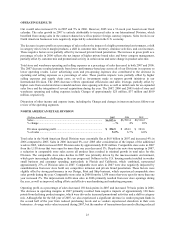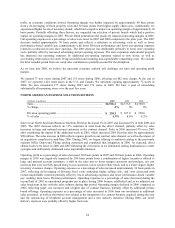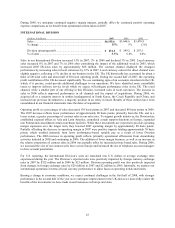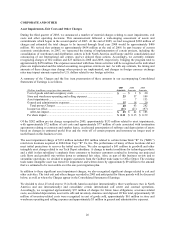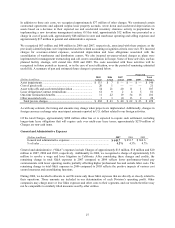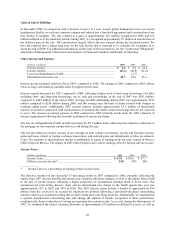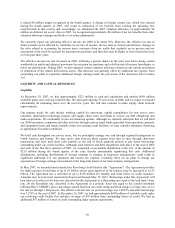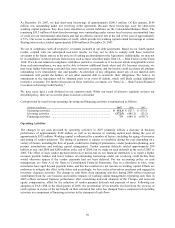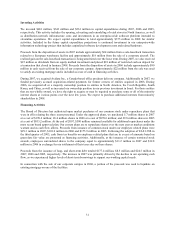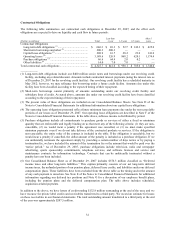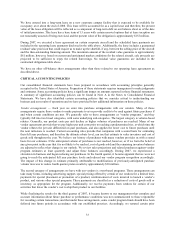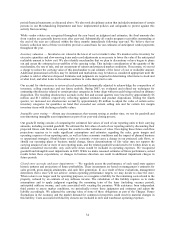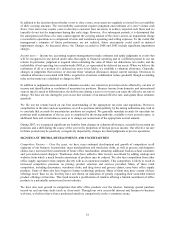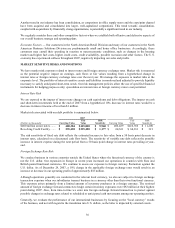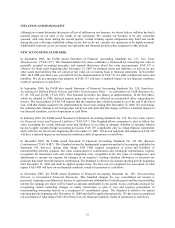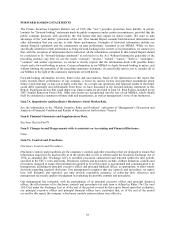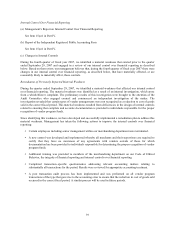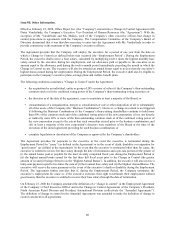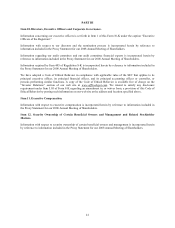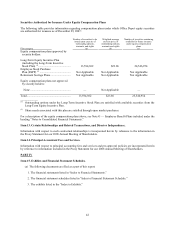Office Depot 2007 Annual Report Download - page 35
Download and view the complete annual report
Please find page 35 of the 2007 Office Depot annual report below. You can navigate through the pages in the report by either clicking on the pages listed below, or by using the keyword search tool below to find specific information within the annual report.33
We have entered into a long-term lease on a new corporate campus facility that is expected to be available for
occupancy at or about the end of 2008. This lease will be accounted for as a capital lease and therefore, the present
value of the lease obligation will be reflected as a component of long-term debt on our balance sheet as of the date
of initial possession. This lease has a base term of 15 years with certain renewal options that at lease inception are
not reasonably assured of being exercised, and the present value of the obligation is approximately $155 million.
During 2007, we executed a lease agreement on certain corporate aircraft and the scheduled lease payments are
included in the operating lease payments disclosed in the table above. Additionally, the lease includes a guaranteed
residual value provision that could require us to make up the shortfall, if any, between the selling price of the aircraft
and the then-outstanding financing amount. The maximum amount of the residual value guarantee is approximately
$61 million; however, based on current and anticipated market conditions for the related aircraft, sale proceeds are
projected to be sufficient to repay the related borrowings. No residual value guarantees are included in the
contractual obligations table above.
We have no other off-balance sheet arrangements other than those related to our operating lease agreements as
described above.
CRITICAL ACCOUNTING POLICIES
Our consolidated financial statements have been prepared in accordance with accounting principles generally
accepted in the United States of America. Preparation of these statements requires management to make judgments
and estimates. Some accounting policies have a significant impact on amounts reported in these financial statements.
A summary of significant accounting policies can be found in Note A in the Notes to Consolidated Financial
Statements. We have also identified certain accounting policies that we consider critical to understanding our
business and our results of operations and we have provided below additional information on those policies.
Vendor arrangements — Each year we enter into purchase arrangements with our vendors. Many of those
arrangements require those vendors to make payments to us or provide credits to be used against future purchases if
and when certain conditions are met. We generally refer to these arrangements as “vendor programs,” and they
typically fall into two broad categories, with some underlying sub-categories. The largest category is volume-based
rebates. Generally, our product costs per unit decline as higher volumes of purchases are reached. Many of our
vendor agreements provide that we pay higher per unit costs prior to reaching a predetermined tier, at which time the
vendor rebates the per unit differential on past purchases, and also applies the lower cost to future purchases until
the next milestone is reached. Current accounting rules provide that companies with a sound basis for estimating
their full year purchases, and therefore the ultimate rebate level, can use that estimate to value inventory and cost of
goods sold throughout the year. We believe our history of purchases with many vendors provides us with a sound
basis for our estimates. If the anticipated volume of purchases is not reached, however, or if we form the belief at
any given point in the year that it is not likely to be reached, cost of goods sold and the remaining inventory balances
are adjusted to reflect that change in our outlook. We review sales projections and related purchases against vendor
program estimates at least quarterly and adjust these balances accordingly. During 2007, we experienced a
slowdown in business and began reducing our purchases. In the fourth quarter, it became apparent that we were not
going to reach the anticipated full year purchase levels and reduced our vendor program recognition accordingly.
The impact of this change in estimate primarily attributable to modifications of previously-anticipated purchase
volume tiers was to reduce fourth quarter pretax results by approximately $30 million.
The second category of arrangements we have with our vendors is event-based programs. These arrangements can
take many forms, including advertising support, special pricing offered by certain of our vendors for a limited time,
payments for special placement or promotion of a product, reimbursement of costs incurred to launch a vendor’s
product, and various other special programs. These payments are classified as a reduction of costs of goods sold or
inventory, as appropriate for the program. Additionally, we receive payments from vendors for certain of our
activities that lower the vendor’s cost to ship their product to our facilities.
While finalizing the results for the third quarter of 2007, it became known to our management that complete and
accurate information about future purchase or performance conditions was not communicated to those responsible
for recording certain transactions; and that under these arrangements, some vendor program funds should have been
deferred into future periods in accordance with our established practices. Accordingly, we restated certain prior


